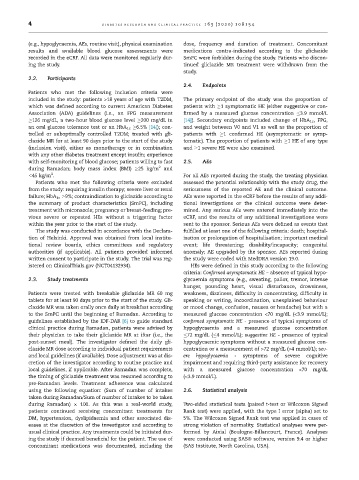Page 75 - Diamicron MR MIG Cycle 2(20-21) Final
P. 75
4 di ab e t es re s e ar ch and c lin i c a l p ra ct ic e 16 3 (20 20) 1 0815 4
(e.g., hypoglycaemia, AEs, routine visit), physical examination dose, frequency and duration of treatment. Concomitant
results and available blood glucose assessments were medications contra-indicated according to the gliclazide
recorded in the eCRF. All data were monitored regularly dur- SmPC were forbidden during the study. Patients who discon-
ing the study. tinued gliclazide MR treatment were withdrawn from the
study.
2.2. Participants
2.4. Endpoints
Patients who met the following inclusion criteria were
included in the study: patients >18 years of age with T2DM, The primary endpoint of the study was the proportion of
which was defined according to current American Diabetes patients with 1 symptomatic HE (either suggestive or con-
Association (ADA) guidelines (i.e., an FPG measurement firmed by a measured glucose concentration 3.9 mmol/L
126 mg/dL, a two-hour blood glucose level 200 mg/dL in [14]). Secondary endpoints included change of HbA 1c , FPG,
an oral glucose tolerance test or an HbA 1c 6.5% [14]); con- and weight between V0 and V1 as well as the proportion of
trolled or suboptimally controlled T2DM; treated with gli- patients with 1 confirmed HE (asymptomatic or symp-
clazide MR for at least 90 days prior to the start of the study tomatic). The proportion of patients with 1 HE of any type
(inclusion visit), either as monotherapy or in combination and 1 severe HE were also examined.
with any other diabetes treatment except insulin; experience
with self-monitoring of blood glucose; patients willing to fast 2.5. AEs
during Ramadan; body mass index (BMI) 25 kg/m 2 and
2
45 kg/m . For all AEs reported during the study, the treating physician
Patients who met the following criteria were excluded assessed the potential relationship with the study drug, the
from the study: requiring insulin therapy; severe liver or renal seriousness of the reported AE and the clinical outcome.
failure; HbA 1c 9%; contraindication to gliclazide according to AEs were reported in the eCRF before the results of any addi-
the summary of product characteristics (SmPC), including tional investigations or the clinical outcome were deter-
treatment with miconazole; pregnancy or breast-feeding; pre- mined. Any serious AEs were entered immediately into the
vious severe or repeated HEs without a triggering factor eCRF, and the results of any additional investigations were
within the year prior to the start of the study. sent to the sponsor. Serious AEs were defined as events that
The study was conducted in accordance with the Declara- fulfilled at least one of the following criteria: death; hospital-
tion of Helsinki. Approval was obtained from local institu- isation or prolongation of hospitalisation; important medical
tional review boards, ethics committees and regulatory event; life threatening; disability/incapacity; congenital
authorities (if applicable). All patients provided informed anomaly; AE upgraded by the sponsor. AEs reported during
written consent to participate in the study. The trial was reg- the study were coded with MedDRA version 19.0.
istered on ClinicalTrials.gov (NCT04132934). HEs were defined in this study according to the following
criteria: Confirmed asymptomatic HE – absence of typical hypo-
2.3. Study treatments glycaemia symptoms (e.g., sweating, pallor, tremor, intense
hunger, pounding heart, visual disturbance, drowsiness,
Patients were treated with breakable gliclazide MR 60 mg weakness, dizziness, difficulty in concentrating, difficulty in
tablets for at least 90 days prior to the start of the study. Gli- speaking or writing, incoordination, unexplained behaviour
clazide MR was taken orally once daily at breakfast according or mood change, confusion, nausea or headache) but with a
to the SmPC until the beginning of Ramadan. According to measured glucose concentration <70 mg/dL (<3.9 mmol/L);
guidelines established by the IDF-DAR [6] to guide standard confirmed symptomatic HE - presence of typical symptoms of
clinical practice during Ramadan, patients were advised by hypoglycaemia and a measured glucose concentration
their physician to take their gliclazide MR at iftar (i.e., the 72 mg/dL ( 4 mmol/L); suggestive HE - presence of typical
post-sunset meal). The investigator defined the daily gli- hypoglycaemic symptoms without a measured glucose con-
clazide MR dose according to individual patient requirements centration or a measurement of >72 mg/dL (>4 mmol/L); sev-
and local guidelines (if available). Dose adjustment was at dis- ere hypoglycaemia - symptoms of severe cognitive
cretion of the investigator according to routine practice and impairment and requiring third-party assistance for recovery
local guidelines, if applicable. After Ramadan was complete, with a measured glucose concentration <70 mg/dL
the timing of gliclazide treatment was resumed according to (<3.9 mmol/L).
pre-Ramadan levels. Treatment adherence was calculated
using the following equation: (Sum of number of intakes 2.6. Statistical analysis
taken during Ramadan/Sum of number of intakes to be taken
during Ramadan) 100. As this was a real-world study, Two-sided statistical tests (paired t-test or Wilcoxon Signed
patients continued receiving concomitant treatments for Rank test) were applied, with the type I error (alpha) set to
DM, hypertension, dyslipidaemia and other associated dis- 5%. The Wilcoxon Signed Rank test was applied in cases of
eases at the discretion of the investigator and according to strong violation of normality. Statistical analyses were per-
usual clinical practice. Any treatments could be initiated dur- formed by Aixial (Boulogne-Billancourt, France). Analyses
ing the study if deemed beneficial for the patient. The use of were conducted using SASÒ software, version 9.4 or higher
concomitant medications was documented, including the (SAS Institute, North Carolina, USA).

